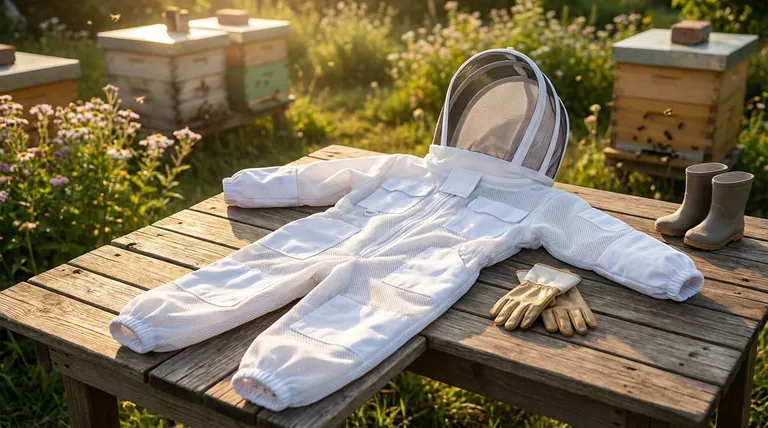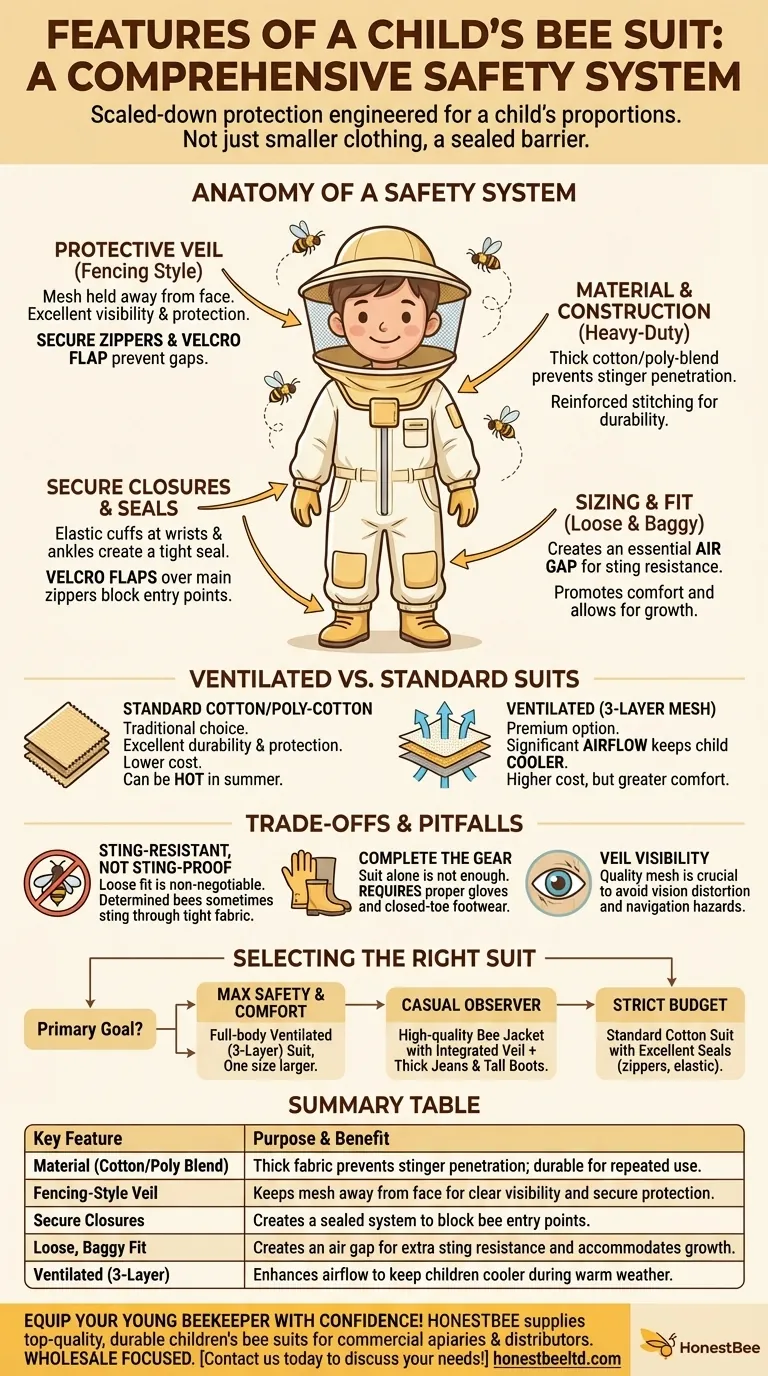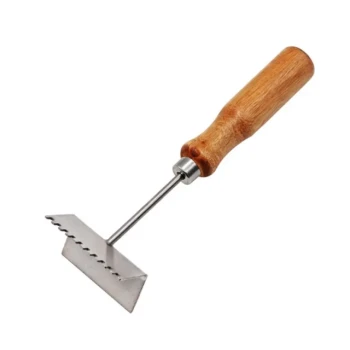At its core, a child's bee suit is a scaled-down version of an adult beekeeper's suit, designed to provide comprehensive protection from bee stings. It is not merely smaller clothing; it is a complete safety system engineered for a child's proportions, featuring specific closures, materials, and a securely attached veil to create a bee-proof barrier.
The single most important takeaway is that a child's bee suit must function as a sealed system. Its effectiveness depends not just on the fabric, but on the integrity of its zippers, wrist and ankle seals, and the connection between the suit and the veil.

The Anatomy of a Child's Bee Suit: A Safety System
A proper bee suit is more than a single piece of clothing. It's an integrated set of components that work together to keep a young beekeeper safe. Understanding these features is critical to making an informed choice.
Material and Construction
The first line of defense is the fabric itself. Most suits are made from a heavy-duty cotton or a poly-cotton blend that is thick enough to prevent a bee's stinger from reaching the skin.
Look for durable, reinforced stitching, especially around zippers and pockets, to ensure the suit can withstand the activity of a child and repeated washings.
The Protective Veil
The veil is arguably the most crucial feature. It protects the sensitive face and neck area while allowing the child to see clearly.
Most children's suits use a "fencing" style veil, which holds the mesh screen away from the face, providing excellent visibility and protection. The veil must attach to the suit with a robust zipper system, often with a Velcro flap covering the zipper pull to prevent any gaps where a bee could enter.
Secure Closures and Seals
Bees are experts at finding small openings. A quality children's suit will have elastic cuffs at the wrists and ankles to create a tight seal against the skin or over gloves and boots.
Zippers on the suit's front, legs, and veil attachment points must be durable and fully close. A Velcro flap over the main zipper provides an essential second layer of security.
Sizing and Fit for Comfort and Safety
Proper fit is a safety feature. The suit should be loose and baggy on the child.
This bagginess creates an air gap between the fabric and the skin, making it much harder for a stinger to penetrate. Always consider buying one size larger than you think you need to accommodate growth and ensure a safe, loose fit.
Ventilated vs. Standard Suits
For children, who can overheat more quickly than adults, the type of suit material is a major consideration for comfort and focus during hive inspections.
Standard Cotton/Poly-Cotton Suits
These are the traditional choice. They offer excellent durability and protection at a lower cost. However, they can become very hot, especially during summer months.
Ventilated (3-Layer) Suits
Ventilated suits are a premium option made of a three-layer mesh sandwich. This design allows for significant airflow, keeping the child much cooler.
While more expensive, the added comfort can make the difference between a pleasant experience and a miserable one, which is vital for fostering a child's interest in beekeeping.
Understanding the Trade-offs and Pitfalls
No piece of equipment is perfect. Being aware of the limitations is key to ensuring a child's safety and enjoyment.
The Myth of "Sting-Proof"
Bee suits are highly "sting-resistant," not "sting-proof." A determined bee can sometimes sting through material, especially if it is pulled tight against the skin. This is why a loose fit is non-negotiable.
Completing the Protective Gear
A suit alone is not enough. You must also equip the child with proper gloves (leather beekeeping gloves are best) and closed-toe footwear (ideally boots that the suit's ankle cuffs can go over). A bee can easily sting an exposed ankle.
Veil Visibility and Distortion
Pay close attention to the quality of the veil's mesh. A cheap or poorly designed screen can distort vision, making it difficult for a child to see properly and navigate around the apiary, which can create its own safety hazard.
Selecting the Right Suit for Your Young Beekeeper
Your final choice depends on the child's level of involvement and your climate.
- If your primary focus is maximum safety and comfort: Choose a full-body, ventilated (3-layer) suit with a fencing-style veil, and purchase it one size larger than needed.
- If your child is only a casual observer for short periods: A high-quality bee jacket with an integrated veil, paired with thick jeans and tall boots, may be sufficient for supervised visits at a distance.
- If you are working within a strict budget: Prioritize a standard cotton suit with excellent seals, ensuring the veil zipper is secure and the wrist and ankle elastics are strong.
Choosing the right protective gear is the first step in sharing the wonder of beekeeping with the next generation safely and confidently.
Summary Table:
| Key Feature | Purpose & Benefit |
|---|---|
| Material (Cotton/Poly Blend) | Thick fabric prevents stinger penetration; durable for repeated use. |
| Fencing-Style Veil | Keeps mesh away from face for clear visibility and secure protection. |
| Secure Closures (Elastic, Zippers, Velcro) | Creates a sealed system to block bee entry points. |
| Loose, Baggy Fit | Creates an air gap for extra sting resistance and accommodates growth. |
| Ventilated (3-Layer) Option | Enhances airflow to keep children cooler during warm weather. |
Equip your young beekeeper with confidence and safety! HONESTBEE supplies commercial apiaries and beekeeping equipment distributors with top-quality, durable children's bee suits designed for maximum protection and comfort. Our wholesale-focused operations ensure you get the best gear to foster a safe and enjoyable beekeeping experience for the next generation. Contact us today to discuss your needs and place an order!
Visual Guide

Related Products
- Vented Beekeeping Jacket with Hood and Veil for Beekeepers
- 3 Layer Mesh Vented Sting Proof Beekeeping Suit with Hat and Veil
- Cotton Beekeeping Suit and Round Hat with Veil Bee Keeper Protective Gear
- Heavy Duty Cowboy Beekeeper Hat with Visibility Veil Outdoor Professional Beekeeping Protective Gear
- Beekeeper Cowboy Hat and Veil for Beekeeping
People Also Ask
- What features should be considered for sting protection in a beekeeping suit? Ensure Total Safety and Comfort
- Why is it important to close all zips and fasten buttons before washing a beekeeping suit? Protect Your Suit & Your Safety
- What should be considered regarding the color of beekeeping clothing? Ensure Your Safety and Keep Bees Calm
- Why is a jacket with a hat veil recommended for beekeepers? Essential Protection for Your Face and Neck
- What should be considered when purchasing a ventilated bee suit? Ensure Maximum Safety and Comfort



















